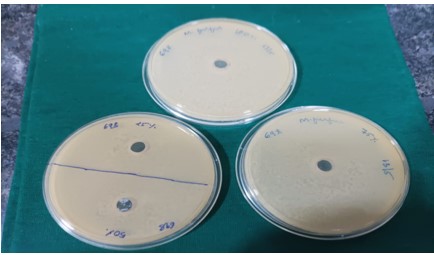In Vitro Anti-Dandruff Activity of Karnasphotha (Cardiospermum helicacabum Linn.) against Malassezia furfur
DOI:
https://doi.org/10.21760/jaims.9.6.8Keywords:
Dandruff, Malassezia globosa, Karnasphota, Agar cup method, Biocidal activityAbstract
Background: Dandruff is a common skin condition that mainly affects the scalp. Almost half of the population at the pre-pubertal age and of any gender and ethnicity will be affected. It was discovered that the responsible agent is a scalp specific fungus, Malassezia globosa. Karnasphotha (Cardiospermum helicacabum Linn.) commonly known as Balloon vine from Sapindaceae family is traditionally used for dandruff. So here an attempt is made to study the in vitro efficacy of Karnasphota (Cardiospermum helicacabum Linn.) decoction against dandruff. Aims and Objectives: In vitro Antidandruff activity of Karnasphota Mula and Beeja by Agar cup method and Biocidal activity. Methodology: In vitro Antidandruff activity of Karnasphota (Cardiospermum helicacabum Linn.) Bija and Mula Kwatha against dandruff by – Agar cup method and Biocidal activity. Result: The Karnasphotha Moola showed good antidandruff activity against Malassezia furfur in different concentrations. Whereas Karnasphotha Beeja showed no antidandruff activity against Malassezia furfur in any concentrations. Conclusion: The Karnasphotha Moola is having significant Antidandruff properties.
Downloads
References
Tucker D, Masood S (August 2021). "Seborrheic Dermatitis". StatPearls [Internet]. Treasure Island (FL): StatPearls Publishing. PMID 31869171
Elewski BE. Clinical diagnosis of common scalp disorders. J Investig Dermatol Symp Proc. 2005;10:190–3. [PubMed] [Google Scholar]
Gupta AK, Batra R, Bluhm R, Boekhout T, Dawson TL., Jr Skin diseases associated with Malassezia species. J Am Acad Dermatol. 2004;51:785–98. [PubMed] [Google Scholar]
Piérard-Franchimont C, Xhauflaire-Uhoda E, Piérard GE. Revisiting dandruff. Int J Cosmet Sci. 2006;28:311–8. [PubMed] [Google Scholar]
Piérard-Franchimont C, Piérard GE, Kligman A. Seasonal modulation of the sebum excretion. Dermatoligica. 1990;181:21–2. [PubMed] [Google Scholar]
https://www.omicsonline.org/india/dandruff-peer-reviewed-pdf-ppt-articles.
nhs.uk. 18 October 2017. Retrieved 1 January 2020.
BBC News. 6 November 2007. Archived from the original on 22 December 2008. Retrieved 30 April 2010.
Ranganathan S, Mukhopadhyay T (2010). "Dandruff: the most commercially exploited skin disease"
Turner GA, Hoptroff M, Harding CR (August 2012). "Stratum corneum dysfunction in dandruff". International Journal of Cosmetic Science. 34 (4): 298–306.
https://en.wikipedia.org/wiki/Dandruff
Kirtikar K K, Basu B D. Indian Medicinal plants. International book distributors Deharadun.1993 Year, page no.622-625.
Deepan T, Alekhya V, Saravanakumar P, Dhanaraju MD. Phytochemical and Anti- Microbial Studies on the Leaves Extracts of Cardiospermum halicacabum Linn. Adv. Biol. Res., 2012; 6(1): 14-18
Rajnighantu with Dravyagunaprakashika hindi vyakhya by Indradev Tripathi, Choukhamba krishnadas academy,Varanasi, (136-137) pp 58.
http://www.ayurveda.hu/api/API-Vol-5.pdf
Mayura Asra, Ten Sacred Angiosperm Treasures of Kerala (Dashapushpam). https://www.ijsr.net/archive /v11i6/SR22604124955.pdf
Mistry Zoya, Gaurav Shah. Anti-Dandruff activity of synthetic and herbal shampoos on dandruff causing isolate: Malassezia. International journal of Applied Research.2016;2(7):80-85















